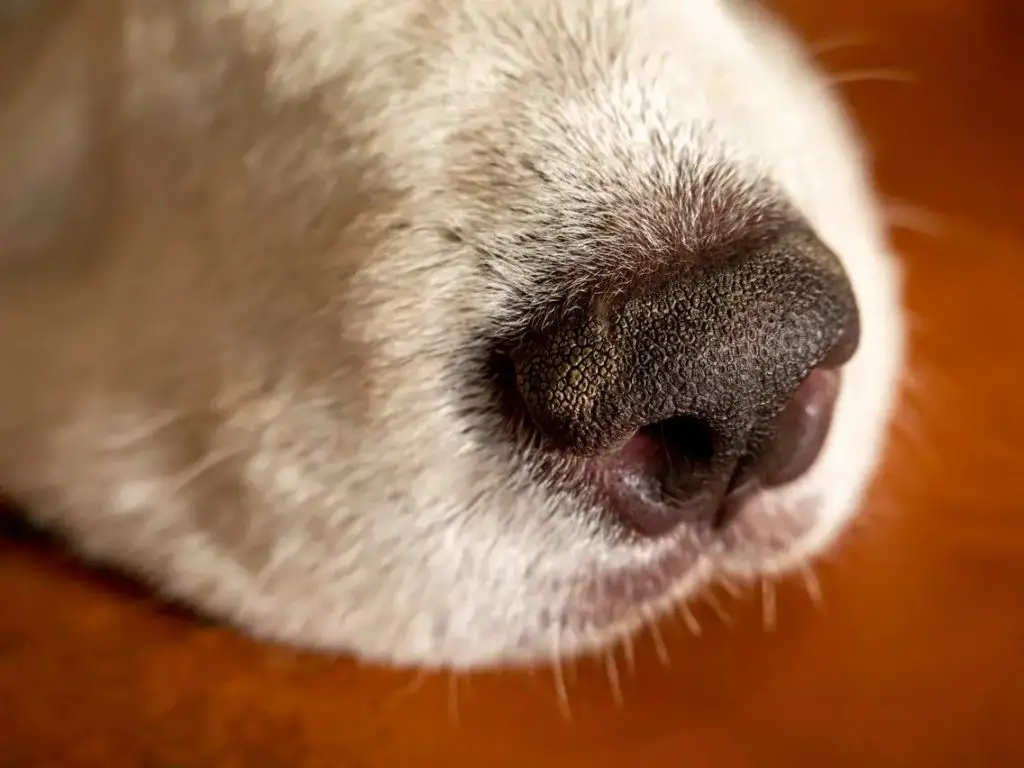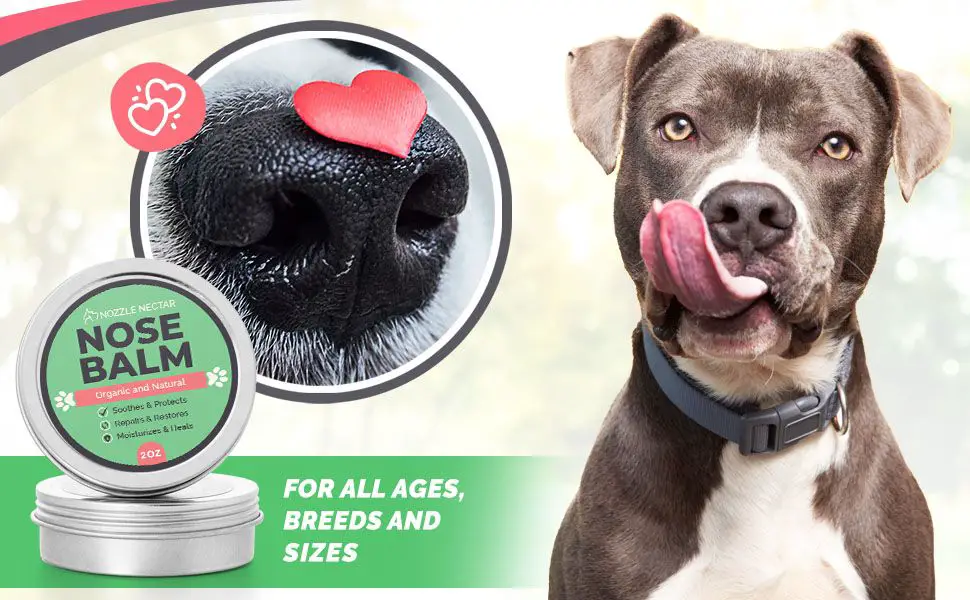Introduction
A dog’s nose is one of its most powerful organs. That familiar cold, wet nose pressing against your hand is full of receptors that allow dogs to experience the world through their sense of smell. A dog’s nose can tell it important information about other animals, people, foods, and the environment. But while a wet nose is normal for healthy dogs, some dogs do have drier noses than others.
In this article, we’ll look at why dogs have wet noses, whether a dry nose indicates a health problem, normal variations in nose moisture, how to care for your dog’s nose, when to see the vet, common nose problems in dogs, and frequently asked questions about why your dog’s nose is dry.
The Purpose of a Dog’s Nose
A dog’s nose serves several important functions related to its sense of smell, breathing, and temperature regulation. First and foremost, the nose contains millions of scent receptors that allow dogs to detect odors at concentrations up to 100 million times lower than humans can. This highly developed sense of smell is critical for hunting, tracking, behavioral communication, and even emotional bonding.

In terms of breathing, a dog’s nose has large nasal passages covered in mucus that warm and filter incoming air before it reaches the lungs. The nose also contains complex folds and structures that allow dogs to properly regulate airflow and respiration.
Lastly, the nose helps regulate a dog’s body temperature. As blood vessels dilate to warm inhaled air, the moist surfaces of the nose help cool this blood through evaporation. This is why dogs pant – to facilitate evaporative cooling through the nose and mouth.
Why Do Dogs Have Wet Noses?
A dog’s nose contains many blood vessels and mucus glands that help keep it moist. This moisture serves several important functions related to your dog’s ability to smell and regulate body temperature.
The mucus secreted in a dog’s nose helps it absorb scent particles. When air passes through the nasal cavity, scent molecules dissolve into the mucus lining the nose. This allows olfactory receptors to detect smells and send signals to the brain. The thin layer of mucus traps and concentrates scent particles much better than dry skin could.
Additionally, the wet nose helps dogs cool off. As blood circulates through the nasal area, the moisture helps regulate body temperature through evaporative cooling. When a dog pants, moisture evaporating off its tongue and nose helps lower its body temperature. A wet nose supports this essential thermoregulation system.
Is a Dry Nose a Health Concern?
In most cases, a dry dog nose does not indicate a major health issue. However, a dry nose accompanied by other symptoms may signal an underlying problem that requires veterinary attention.
Some signs that a dry nose could mean illness include:

- Lethargy or lack of appetite
- Vomiting or diarrhea
- Fever
- Nasal discharge
- Sneezing or breathing issues
- Crusting of the nose
- Loss of smell
Keep in mind that certain factors can also temporarily cause a dry nose without illness, such as:
- Sleeping
- Stress or anxiety
- Overheating
- Dry air conditions
Monitor any nasal dryness along with other symptoms to determine if a vet visit is needed. Contact your veterinarian if your dog’s dry nose persists or worsens.
Normal Nose Wetness Variations
While a moist nose is normal for a healthy dog, the amount of moisture on the nose may vary somewhat depending on the dog’s daily activities and environment. Here are some common reasons a dog’s nose may be wetter or drier at different times:
Sleep – A dog’s nose tends to get drier when they are sleeping or resting. This is normal as they are not actively sniffing and licking their nose during this time.

Environment – Dogs in hot, dry environments may have drier noses than dogs living in cool, humid areas. The ambient temperature and humidity levels can cause variations in nasal moisture.
Activity Level – An active, playing dog will have a wetter nose than a resting dog, as their increased sniffing and panting leads to more moisture on their nose. The nasal passages also open up more during physical activity.
So in summary, while you want your dog’s nose to be predominantly moist, some natural fluctuation with activities is perfectly normal. Only significant or persistent dryness could be cause for concern.
Caring for Your Dog’s Nose
A dog’s nose needs a little bit of extra care and attention to keep it healthy. Here are some tips for taking care of your pup’s snout:

-
Use dog-safe sunscreen on your dog’s nose when spending time outdoors, especially dogs with light-colored noses. The sun can cause sunburn and skin cancer on dog noses.
-
Wipe your dog’s nose clean after outdoor activities where the nose may pick up dirt, debris, pollen or chemicals. Use a gentle dog facial wipe or wet cloth. Don’t use human soaps or tissue.
-
Rinse your dog’s nose with water after swimming to remove chlorine or salt from pool and ocean water. This helps prevent dryness and irritation.
-
Apply a thin layer of pet-safe nose balm if your dog’s nose is cracked or dry. Look for moisturizing ingredients like shea butter, vitamin E and aloe.
-
Avoid letting your dog stick their nose into toxic substances like gasoline, solvents, weed killers, oils, antifreeze, paints, or chemicals.
-
Make sure your dog always has access to fresh, clean drinking water to stay hydrated.
Taking steps to protect your dog’s nose from harsh elements and keep it clean and moisturized will help maintain your pup’s nose health.
When to See the Vet
While some variations in nose wetness are normal in healthy dogs, certain symptoms warrant a trip to the veterinarian. Contact your vet if you notice any of the following:
- Excessive nasal discharge – Clear discharge from one or both nostrils could indicate an upper respiratory infection or allergies. Yellow, green, or bloody discharge may signal a foreign object, tumor, or infection.
- Crusting around the nose – If the skin around your dog’s nose is crusty or scabbed, it could point to an autoimmune disease, tumor, or fungal infection.
- Nasal lesions or sores – Red, inflamed sores or lesions on a dog’s nose may be caused by sunburn, an infection, or autoimmune disorder.
- Abnormal nose color – If your dog’s nose changes color significantly, turning white, blue, or bright red, see your vet to rule out problems.
- Difficulty breathing – Labored breathing through the nose, loud nasal sounds, or mouth breathing can indicate an obstruction or inflammation.
Schedule a veterinary exam if your dog shows any unusual nasal symptoms. Prompt diagnosis and treatment can help resolve many nose problems and prevent complications.
Nose Problems in Dogs
A dog’s nose can develop several health issues that require veterinary attention. Some common nose problems in dogs include:
Allergies
Dogs can suffer from allergic rhinitis, which causes inflammation of the nasal passages. This leads to symptoms like sneezing, nasal discharge, nosebleeds, and crusting around the nose. Allergies to pollen, dust, mold, and other environmental irritants are often the underlying cause. Treatment typically involves medications like antihistamines and corticosteroids to control the allergic response.
Foreign Objects
Dogs are curious and may end up with foreign objects like grass seeds lodged in their nasal passages. Signs include pawing at the nose, sneezing, and nasal discharge or bleeding. Veterinary extraction of the object is required.
Nasal Tumors
Tumors can develop in a dog’s nasal cavity or sinuses. These are often malignant cancers like adenocarcinoma. Symptoms include nasal discharge, nosebleeds, facial swelling, and difficulty breathing. Treatment depends on the type and location of the tumor, and may involve surgery, radiation therapy, or chemotherapy.
FAQs
Why do some dogs have dry noses?
There are a few reasons why a dog’s nose may be dry when it is normally wet. This includes dementia, where a senior dog forgets to lick its nose, as well as anxiety, stress or fear causing panting that dries out the nose. Certain medications like diuretics can also cause dry nose. In some cases, a dog just has natural variations in nose moisture.
Is a dry nose a sign of fever in dogs?
Yes, a dry nose can sometimes indicate a fever or overheating in dogs. The nose is normally wet to facilitate evaporation, which cools the body. When a dog is too hot, the body reduces nasal moisture to prevent this cooling effect. So a dry nose may mean the dog is running a temperature.
When should I be concerned about my dog’s dry nose?
In most cases, a temporarily dry nose is not a cause for concern, especially if your dog is otherwise acting normal. However, if the nose stays dry for over 24 hours, or if other symptoms like lethargy, appetite changes, or nasal crusting develop, it’s a good idea to call your vet.
What can I do to keep my dog’s nose wet?
Making sure your dog stays hydrated by having access to fresh, clean water can help their nose stay moist. You can also apply a thin layer of pet-safe moisturizer to the nose. This provides a barrier against drying. Avoid overuse of moisturizer, as this can clog pores. And never use human lotions, as these can be toxic to dogs if ingested.
Why does my puppy have a dry nose?
It’s very common for puppies to have dry noses as they develop. Their nose leather is still maturing, so it may not be fully functional yet. As long as the pup is active and eating well, a dry nose is not a concern. Make sure they have access to water and their nose should moisten up within a couple months.
The Bottom Line
A wet nose is completely normal and healthy for dogs. Dogs’ noses are designed to be wet to help them smell. The normal amount of nose wetness varies between breeds and individuals. Some dogs naturally have drier noses than others. Minor natural fluctuations in wetness are also normal throughout the day or due to weather.
While a healthy dog’s nose is wet, a persistently dry nose could indicate a medical issue. Potential causes include fever, dehydration, allergies, or nasal disease. Consult your veterinarian if your dog’s nose is consistently dry or crusty.
Key takeaways:
- A moist, wet nose is normal for dogs and aids their sense of smell.
- Nose wetness varies between individual dogs based on breed, age, weather, and health.
- See your vet if your dog’s nose is persistently dry, crusty, or cracked as it could signal an underlying health issue.
- Monitor for other symptoms and care for your dog’s nose by gently wiping away dirt and applying pet-safe balms.